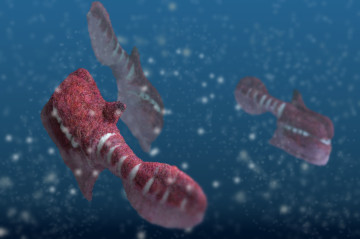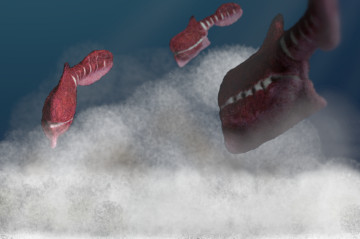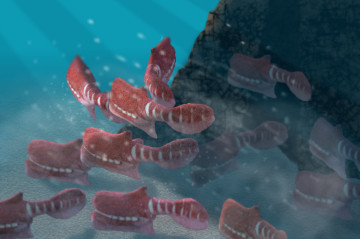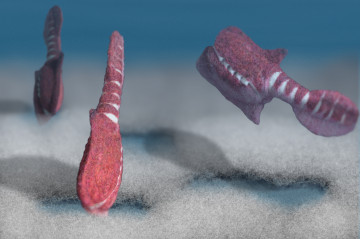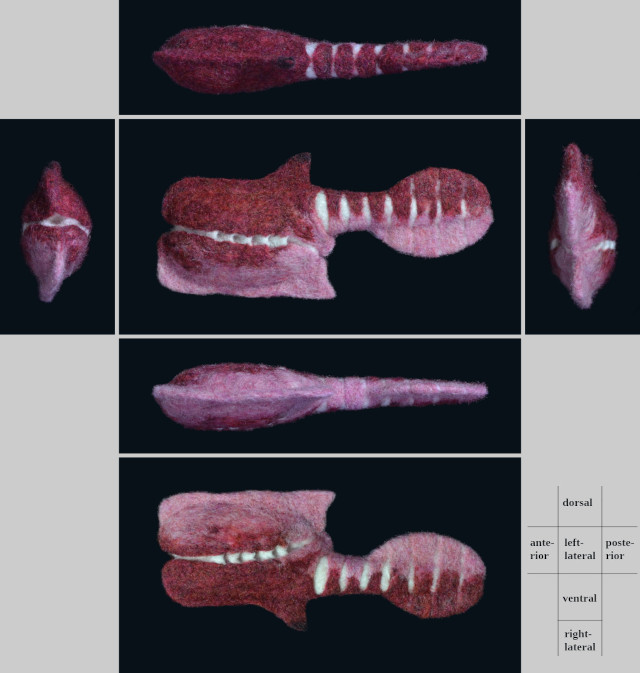Vetulicola rectangulate
Vetulicola is a bizarre and enigmatic genus of the Early Cambrian 1), 2), and its representative species are V. cuneata and V. rectangulata 4).
Vetulicolians (Class Vetulicolida), which the genus Vetulicola is classified into, have a bipartite body 4). The anterior of V. rectangulata is about 5 - 7cm in length and about 3 - 4cm in height 1), the posterior is appoximatelly 2.5 - 3cm (measured on Plate 1 - Figure 9 of the reference 1), so the total length of V. rectangulata may be 10cm or so.
The anterior section of V. rectangulata has a subrectangular shape in lateral view, and has relatively robust "coverings" 1). The anterior body is surrounded with marginal zones formed by the coverings, and has a fin-like projection at posterodorsal corner and additional short projections at the midpoint of the posterior edge and at the posteroventral corner 1).
The posterior body consists of seven segments 1). Each segments also have "coverings" and are connected by more flexible "articulating membranes" 6). Last four segments support flaps forming an ovoid structure 1). This region is extended vertically, and the posterior section has flexibility in lateral direction 2), 4), 5).
There is an alimentary canal along the axis of posterior body, and the anus seems to open at terminal 1).
Neither jointed appendages nor eyes have been identified in the vetulicolians 4), 5).
The Vetulicola had not any chewing mechanisms, so that they were probably nektobenthic (swimmers near the bottom of the sea) and filter-feeders 1), or supension-feeders 3).
They could swallowed voluminous quantities of seawater by expanding their internal cavity, subsequently, contraction of the cavity had served to expel the water through the gill-openeings 3). Presumably, some gas-exchange have occured in their cavity, or through the lateral openings 3). The expulsion of water may have helped their swimming 1).
References:
- Aldridge RJ, Xian‐Guang H, Sivester DJ, Sivester DJ, Gabbott SE (2007) The systematics and phylogenetix relationships of Vetulicolians. Palaeontology 50: 131-168. (DOI:10.1111/j.1475-4983.2006.00606.x.)
- García-Bellido DC, Lee MSY, Edgecombe GD, Jago JB, Gehling JG, Paterson JR (2014) A new vetulicolian from Australia and its bearing on the chordate affinities of an enigmatic Cambrian group. BMC Evol Biol 14, 214. (DOI:10.1186/s12862-014-0214-z.)
- Ou Q, Conway Morris S, Han J, Zhang Z, Liu J, Chen A, Zhang X, Shu D (2012) Evidence for gill slits and a pharynx in Cambrian vetulicolians: implications for the early evolution of deuterostomes. BMC Biol 10, 81. (DOI: 10.1186/1741-7007-10-81.)
- Shu DG, Conway Morris S, Han J, Chen L, Zhang XL, Zhang ZF, Liu HQ, Liu JN (2001) Primitive deuterostomes from the Chengjiang Lagerstätte (Lower Cambrian, China). [abstract] Nature 414: 419-424. (DOI:10.1038/35106514.) (The full-text was referred to ResearchGate.)
- Shu DG, Conway Morris S, Zhang ZF, Han J (2010) The earliest history of the deuterostomes:the importance of the Chengjiang Fossil-Lagerstätte. Proc. R. Soc. B 277:165-174. (DOI:10.1098/rspb.2009.0646.)
- Vinther J, Smith MP, Harper DAT (2011) Vetulicolians from the Lower Cambrian Sirius Passet Lagerstätte, North Greenland, and the polarity of morphological characters in basal deuterostomes. Palaeontology 54: 711-719. (DOI:10.1111/j.1475-4983.2011.01034.x.)

